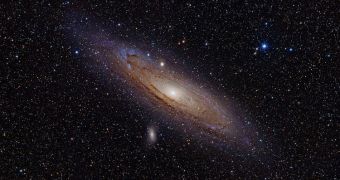In-depth studies of the Universe have revealed years ago that the overall rate of star formation peaked when the Cosmos was only a few billion years old. Since then, it has been in a steep decline, and a new study proposes that dark energy may somehow be responsible for this.
When it comes to forming new stars – and therefore new star clusters and galaxies – the main ingredient is molecular hydrogen gas. While the chemical still exists in copious amounts in the Cosmos, current volumes are nothing compared to those shortly after the Big Bang.
In recent investigations, researchers demonstrated that galaxies located 3 to 5 billion light-years away from Earth have considerably larger gas reserves, and more stars than modern galaxies. The trend appears to be uniform wherever astronomers look.
When it comes to stellar formation, the material used to create a new star is not lost once the star dies. Violent type II supernova explosions give some of the material back to their host galaxies or stellar nurseries, promoting further stellar formation.
However, astrophysicists have calculated that the amounts involved are way smaller than the ones used up to create the progenitor stars for the supernova blasts. Interestingly enough, a new study shows that hydrogen gas amounts began decreasing when dark energy started taking over the Universe.
This conclusions are based on data obtained using the CSIRO Mopra radio telescope, which is located near Coonabarabran, in New South Wales, Australia. Astronomer Dr Robert Braun led the study.
“Our result helps us understand why the lights are going out. Star formation has used up most of the available molecular hydrogen gas. The drop-off in both gas availability and star formation seems to have started around the time that dark energy took control of the Universe,” he explains.
About 70 percent of the gas originally used to make new stars “remains locked up, having been turned into things such as white dwarfs, neutron stars and planets,” the team leader goes on to say.
“So the molecular gas is used up over time. We find that the decline in the molecular gas is similar to the pattern of decline in star formation, although during the time interval that we have studied, it is declining even more rapidly,” he argues, quoted by Daily Galaxy.
The mechanism that dark energy may have used to achieve this effect is rather simple. Due to the fact that galaxies are flying apart from each other at increasingly higher speeds, it is becoming more and more difficult for them to recapture used gas, and create new stars.

 14 DAY TRIAL //
14 DAY TRIAL //